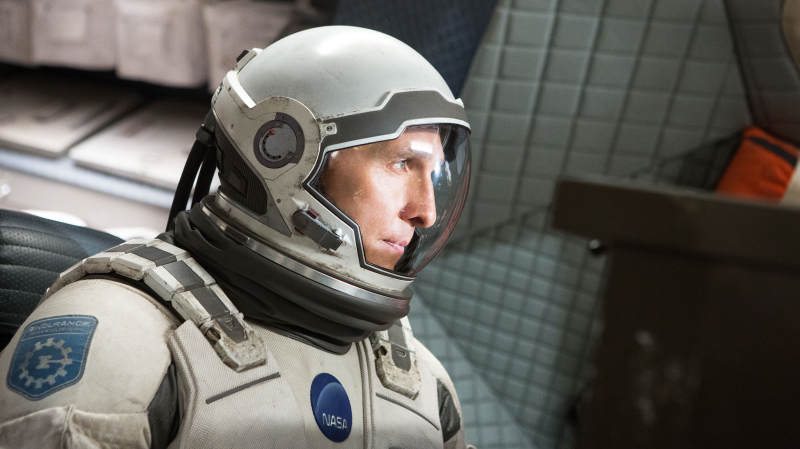NASA is a secret organization led by Michael Caine, Nolan’s go-to man for gravitas. In fact, his character is literally a gravity expert, one who has spent decades trying to crack an equation that will enable humanity’s migration to Somewhere Else. What’s more, his team — Anne Hathaway, David Gyasi and Wes Bentley, plus a sarcastic military-surplus robot voiced and manipulated, at least in some scenes, by the brilliant, elastic-limbed clown Bill Irwin — have identified a dozen potentially habitable planets accessible via wormhole, those express lanes across the cosmos that Thorne has theorized. NASA’s best guess is that the wormhole and the planets were put there for us by extraterrestrial intellects vast, cool and weirdly sympathetic. But they need Cooper’s Right Stuff to get to Saturn, where the wormhole is. It’s unclear who was going to handle the driving if an eventually explained series of mysterious portents hadn’t led Cooper and Murph, his 10-year-old budding genius daughter, to their secret lair.
The Earthbound first act feels a lot like the Spielberg picture this was once set to be. (Also like M. Night Shyamalan’s thriller Signs, starring America’s favorite stoic widower circa 2002, Mel Gibson.) As with every Nolan movie, there’s a clockwork narrative logic to it that eventually reveals itself, even if your willing suspension of disbelief has burned up by then.
Anyway, Cooper must leave behind his two kids — Murph and Tom, her less gifted big brother — to try to save the species. Kubrick wouldn’t have wasted a tear on an equation as lopsided as that, but Nolan turns on the waterworks (and Hans Zimmer’s church-organ score), cutting from the bereft Cooper’s drive away from his Norman Rockwell-esque house to the countdown of his rocket. It’s the first of many bravura dialogue-free moments that make Interstellar‘s 169 minutes feel … well, like less than 169 minutes. (I saw it twice in three days and I was never bored.) Here’s another: Their spacecraft, bearing the weary designation Endurance, pinwheels across the rings of Saturn while we hear the thunderstorm-sounds recording Gyasi is playing on his headphones.
I wouldn’t have minded a bit if Nolan had lingered on these space vistas more than he does. (Cinematographer Hoyte van Hoytema, of Let the Right One In and Her, has composed frames well worth the extra few bucks to see them in true IMAX.) But he’s got a supermassive (and highly spoilable) story to tell, one that keeps him rushing even given the lengthy run time. One thing Kubrick never was was hurried.
Iceland stands in for a pair of beautiful, forbidding planets, but its most stunning environments are computer visualizations born of legit science: Thorne gave the film’s army of digital effects artists the equations to visualize both the wormhole and the black hole seen in the film, leading to breakthroughs in “gravitational lensing.” Nolan had reserved the right to assert artistic license if the images Thorne’s equations produced were too plain or simply too weird for audiences to process, but the objects his data generated — a shiny black soap-bubble in space, and a black hole with a fiery halo of starlight wrapped around it like the string of a yo-yo — are what we see. “This is our observational data,” Thorne told Wired magazine. “That’s the way nature behaves. Period.” (This is not to say others don’t take issue with the science on the whole, as astronomer Phil Plait does in Slate.)
Nolan made his name with Memento, a tricksy mystery that moved in two temporal directions at once. In the 14 years since, his movies have swollen to monumental scale, but he still compresses and elongates the fourth dimension more poetically than any other blockbuster-maker. Who better than him to make a film dealing so explicitly with relativity?
Other good sci-fi pictures have addressed the existential, sanity-testing loneliness of sailing across eternity in a can. Interstellar does that, too, but it’s probably the first presumptive blockbuster to grapple, even clumsily, with the problem that everyone you loved back on your home world would almost certainly grow to surpass you in age. (It takes two years in cryo-sleep just to get to the wormhole, apart from the time-dilation problem.) Some of the consequences of this make for stirring, emotional stuff, even if the movie isn’t as profound as it wants us to believe.

9(MDAxOTAwOTE4MDEyMTkxMDAzNjczZDljZA004))

